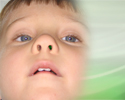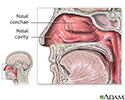Foreign body in the nose
Something stuck in the nose; Objects in the nose
This article discusses first aid for a foreign object placed into the nose.
Considerations
Curious young children may insert small objects into their nose in a normal attempt to explore their own bodies. Potential objects placed in the nose may include food, seeds, dried beans, small toys (such as marbles), crayon pieces, erasers, paper wads, cotton, and beads.
A foreign body in a child's nose can be there for awhile without a parent being aware of the problem. The object may only be discovered when visiting a health care provider to find the cause of irritation, bleeding, infection, or difficulty breathing.
Symptoms
Symptoms that your child may have a foreign body in his or her nose include:
-
Difficulty breathing
through the affected nostril
Difficulty breathing
Breathing difficulty may involve:Difficult breathingUncomfortable breathingFeeling like you are not getting enough air
 ImageRead Article Now Book Mark Article
ImageRead Article Now Book Mark Article - Feeling of something in the nose
-
Foul-smelling or bloody
nasal discharge
Nasal discharge
A stuffy or congested nose occurs when the tissues lining the nose become swollen. The swelling is due to inflamed blood vessels. The problem may a...
 ImageRead Article Now Book Mark Article
ImageRead Article Now Book Mark Article - Irritability, particularly in infants
- Irritation or pain in the nose
First Aid
- DO NOT search the nose with cotton swabs or other tools. This may push the object further into the nose.
- DO NOT use tweezers or other tools to remove an object that is stuck deep inside the nose.
- DO NOT try to remove an object that you cannot see or one that is not easy to grasp. This can push the object farther in or cause damage.
- Have the person breathe through the mouth. The person should not breathe in sharply. This may force the object in further.
- Gently press and close the nostril that does NOT have the object in it. Ask the person to blow gently. This may help push the object out. Avoid blowing the nose too hard or repeatedly.
- If this method fails, get medical help.
When to Contact a Medical Professional
Get medical help right away if:
- The person cannot breathe well
- Bleeding occurs and continues for more than 2 or 3 minutes after you remove the foreign object, despite placing gentle pressure on the nose
- An object is stuck in both nostrils
- You cannot easily remove a foreign object from the person's nose
- You think an infection has developed in the nostril where the object is stuck
Prevention
Prevention measures may include:
- Cut food into appropriate sizes for small children.
- Discourage talking, laughing, or playing while food is in the mouth.
- Do not give foods such as hot dogs, whole grapes, nuts, popcorn, or hard candy to children under age 3.
- Keep small objects out of the reach of young children.
- Teach children to avoid placing foreign objects into their noses and other body openings.
References
Cukor J, Manno M. Pediatric respiratory emergencies. In: Marx JA, Hockberger RS, Walls RM, et al, eds. Rosen's Emergency Medicine: Concepts and Clinical Practice . 8th ed. Philadelphia, PA: Elsevier Saunders; 2014:chap 168.
Thomas SH, Goodloe JM. Foreign bodies. In: Marx JA, Hockberger RS, Walls RM, et al., eds. Rosen's Emergency Medicine: Concepts and Clinical Practice . 8th ed. Philadelphia, PA: Elsevier Saunders; 2014:chap 60.
-
What to do when kids put things in their nose
Animation
-
Nasal anatomy - illustration
The nasal cavity is the first part of the respiratory system where air enters to begin the breathing process. The nasal conchae are so called for their shell-shaped structure. The conchae form the lateral walls of the nasal cavity.
Nasal anatomy
illustration
Review Date: 1/12/2015
Reviewed By: Jacob L. Heller, MD, MHA, Emergency Medicine, Virginia Mason Medical Center, Seattle, WA. Also reviewed by David Zieve, MD, MHA, Isla Ogilvie, PhD, and the A.D.A.M. Editorial team.


